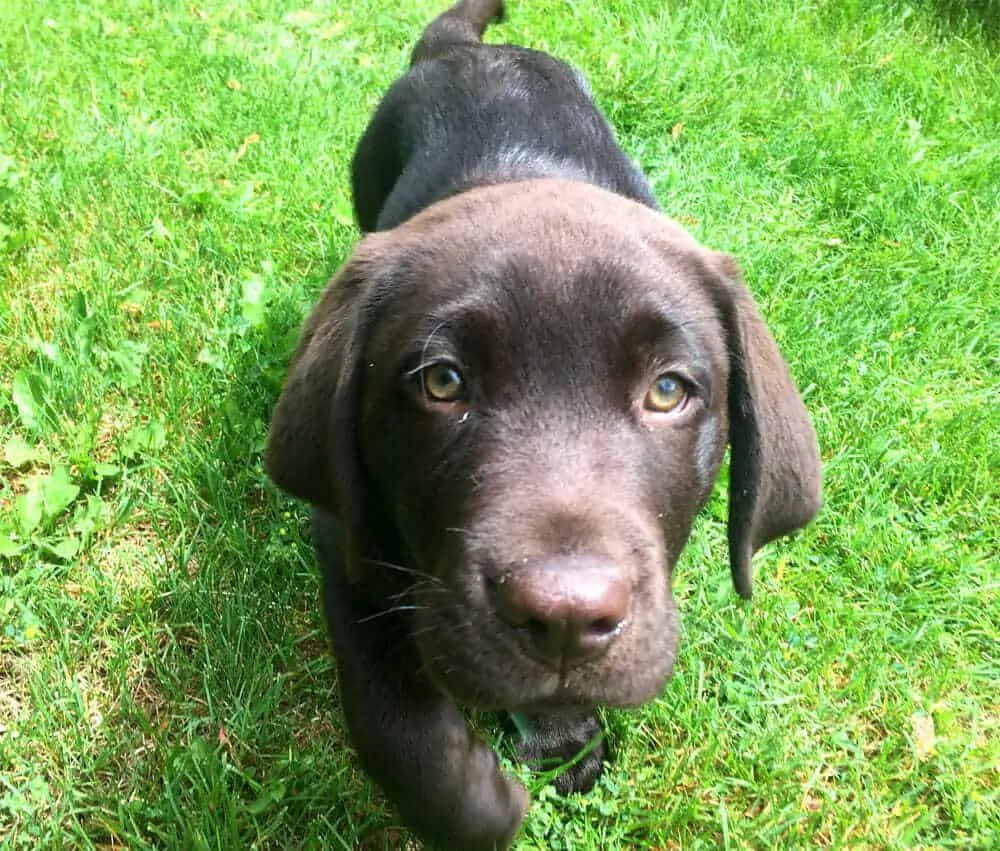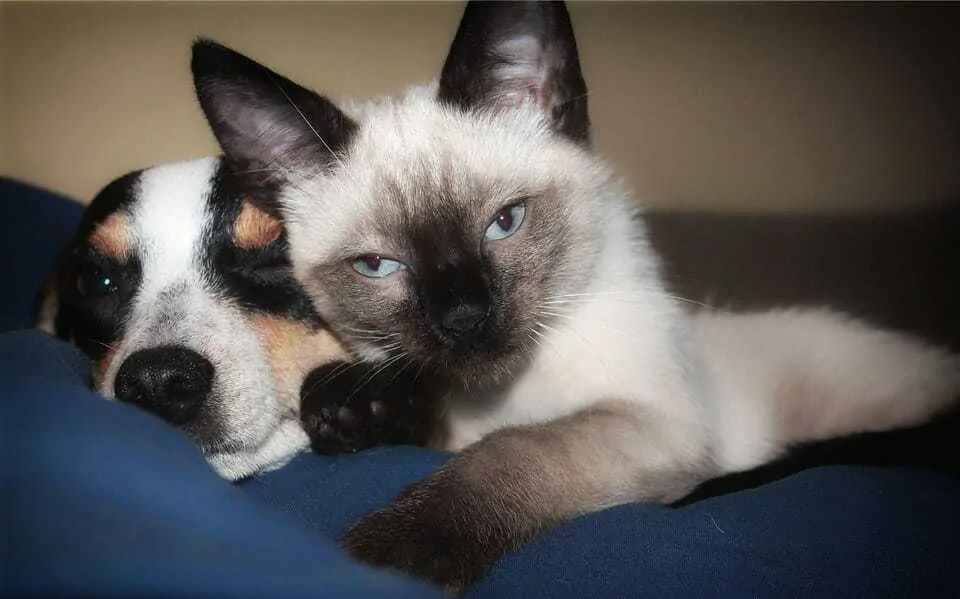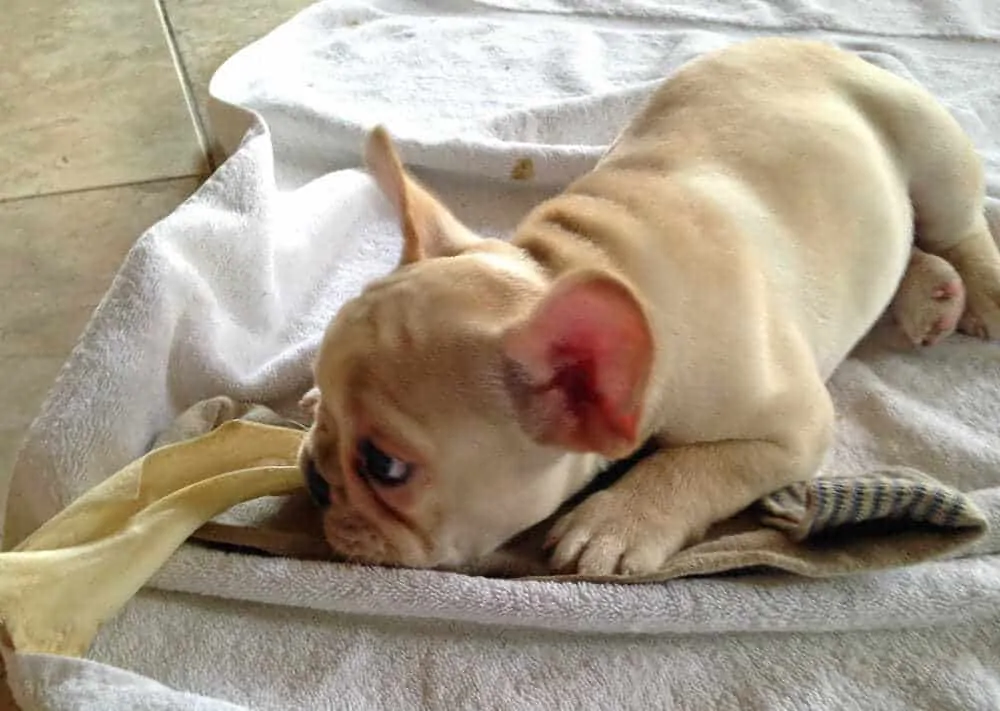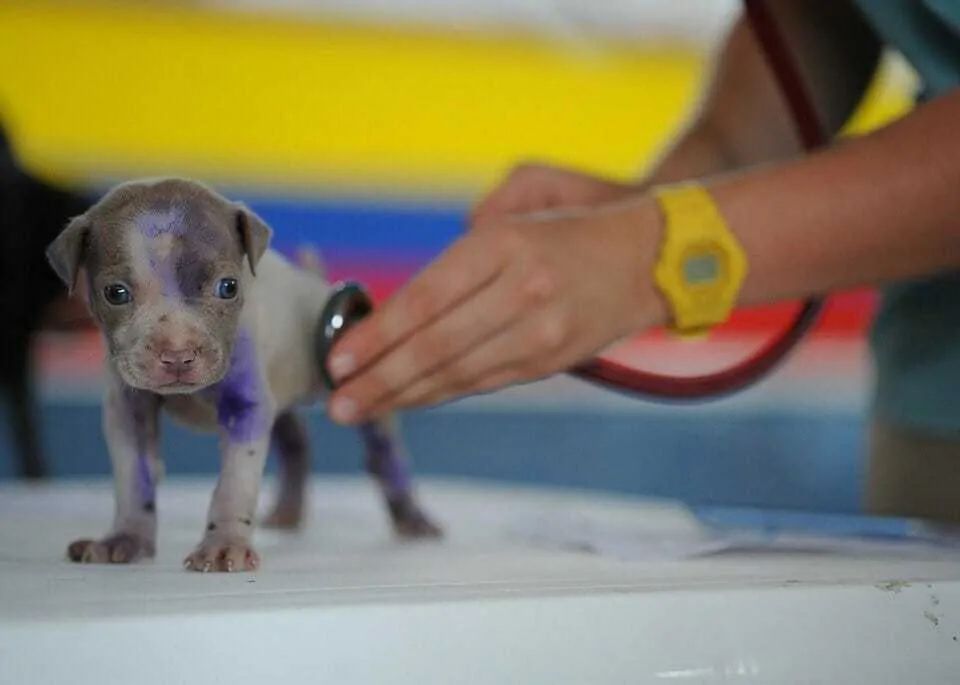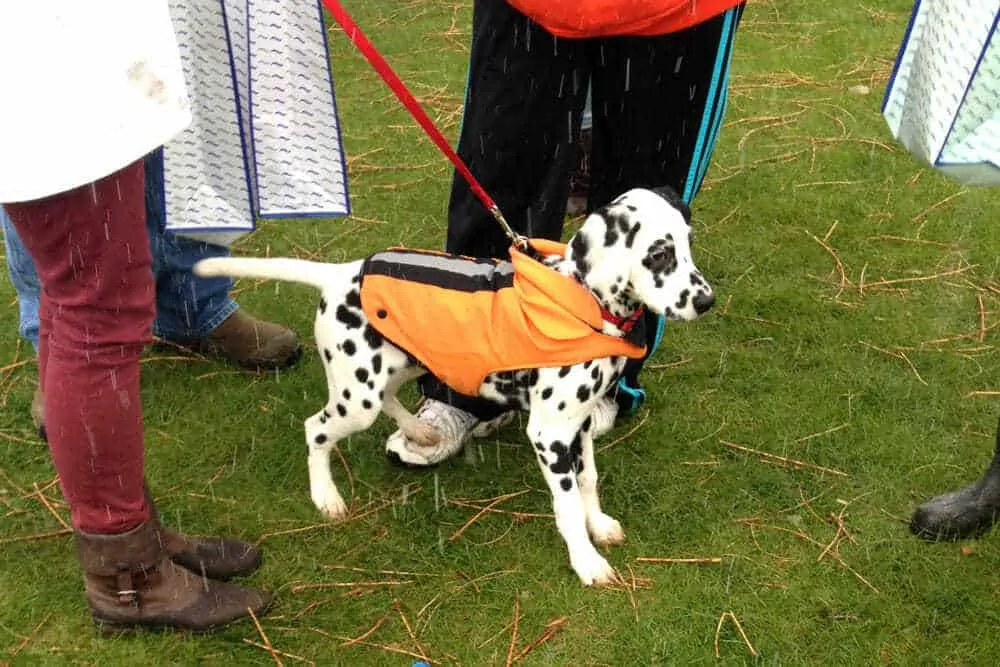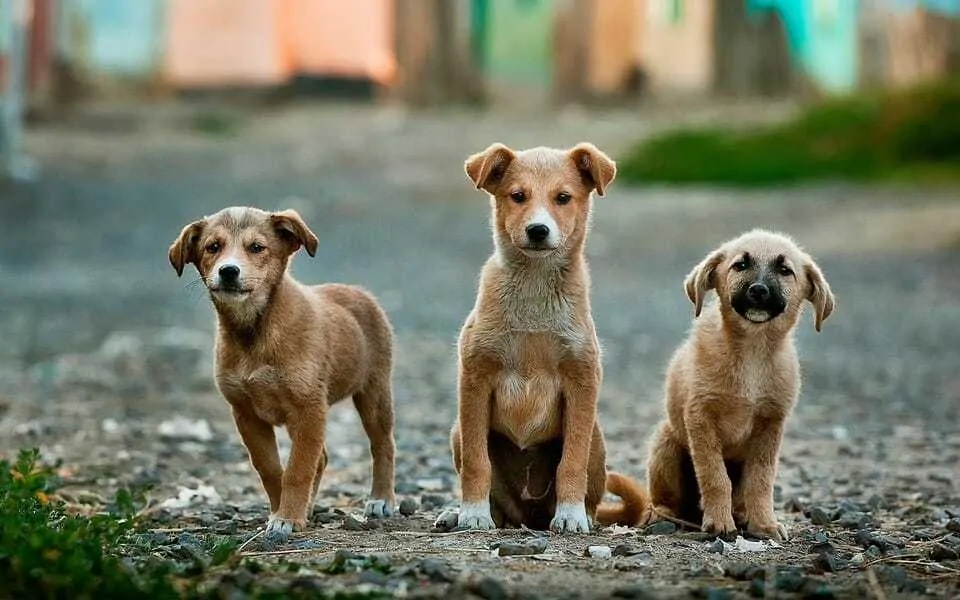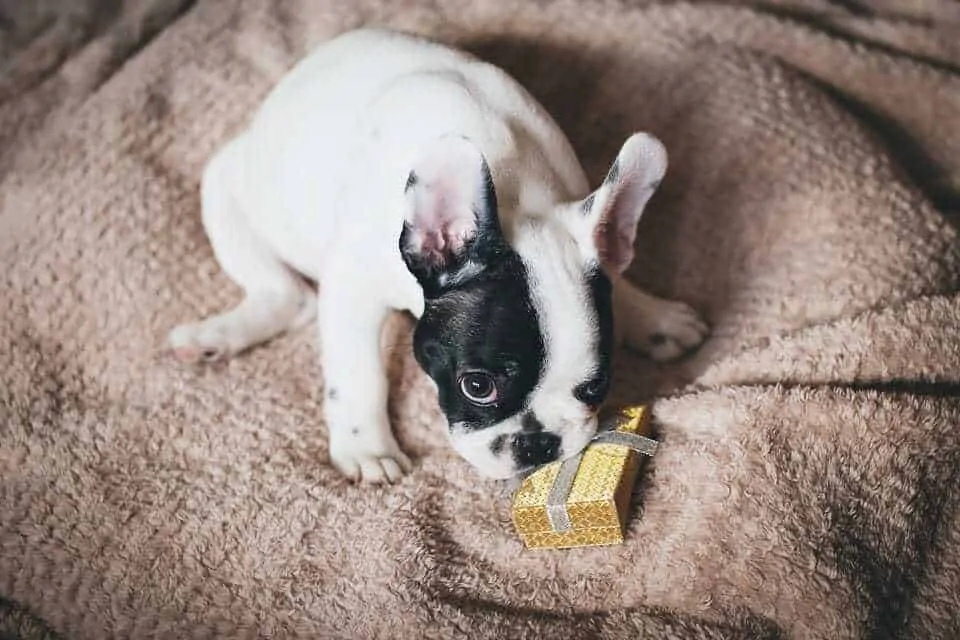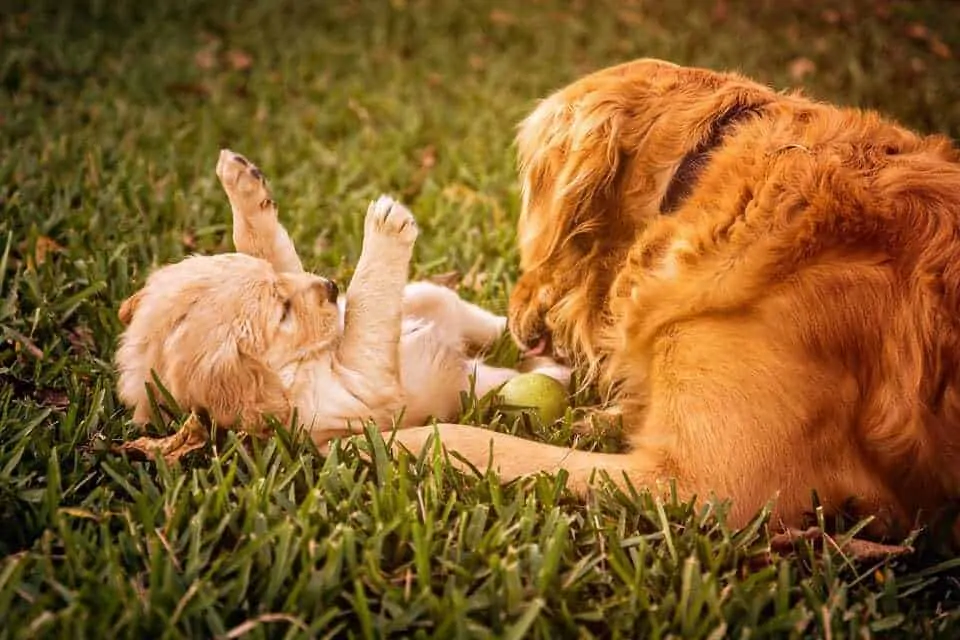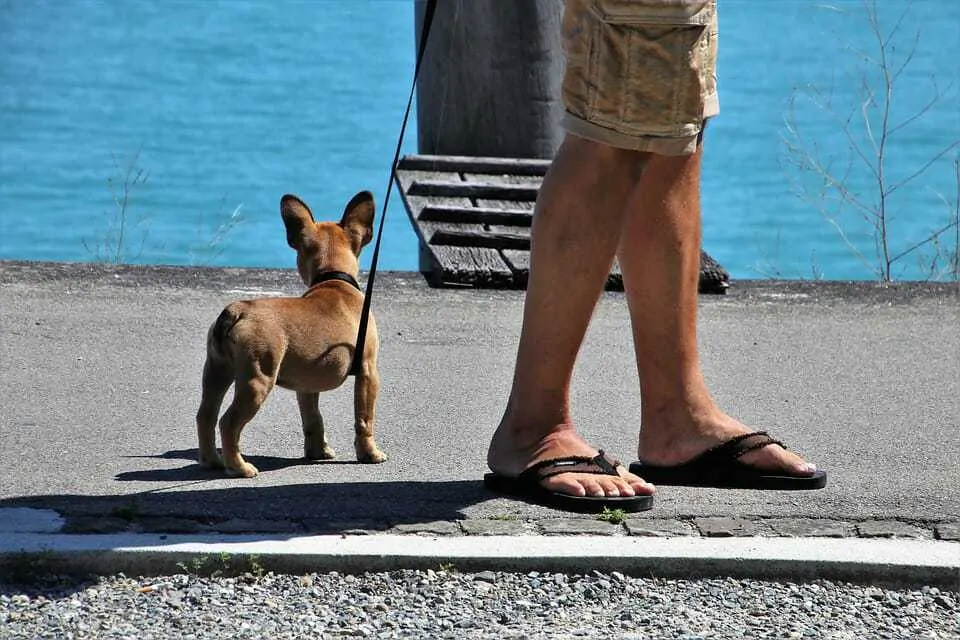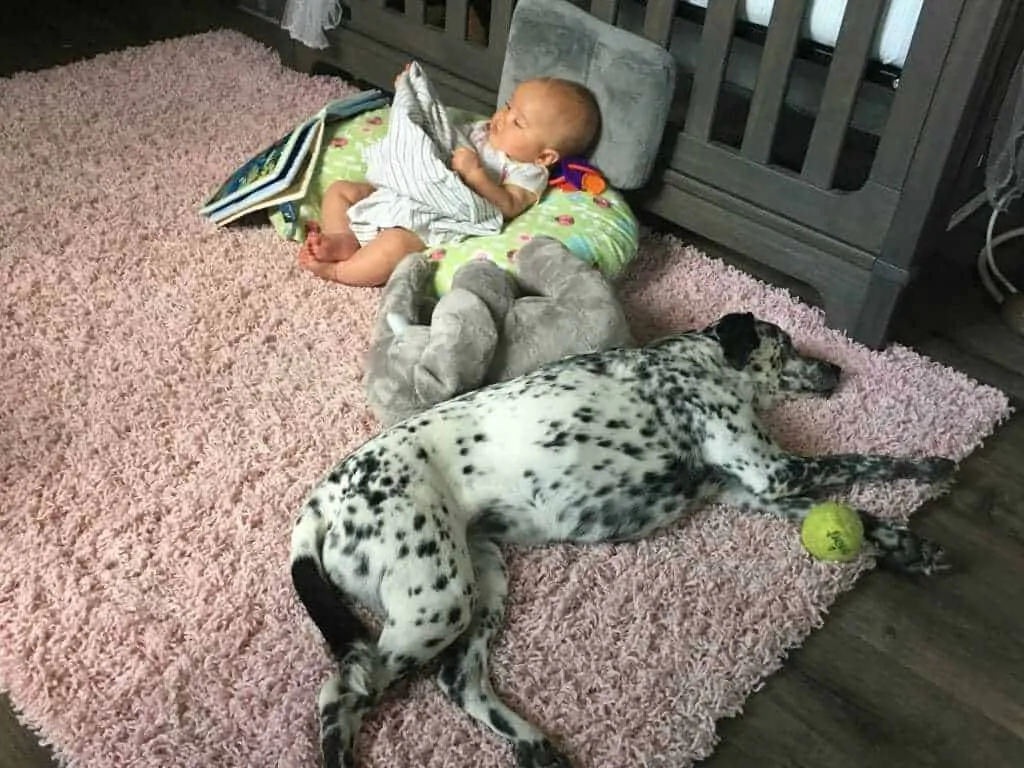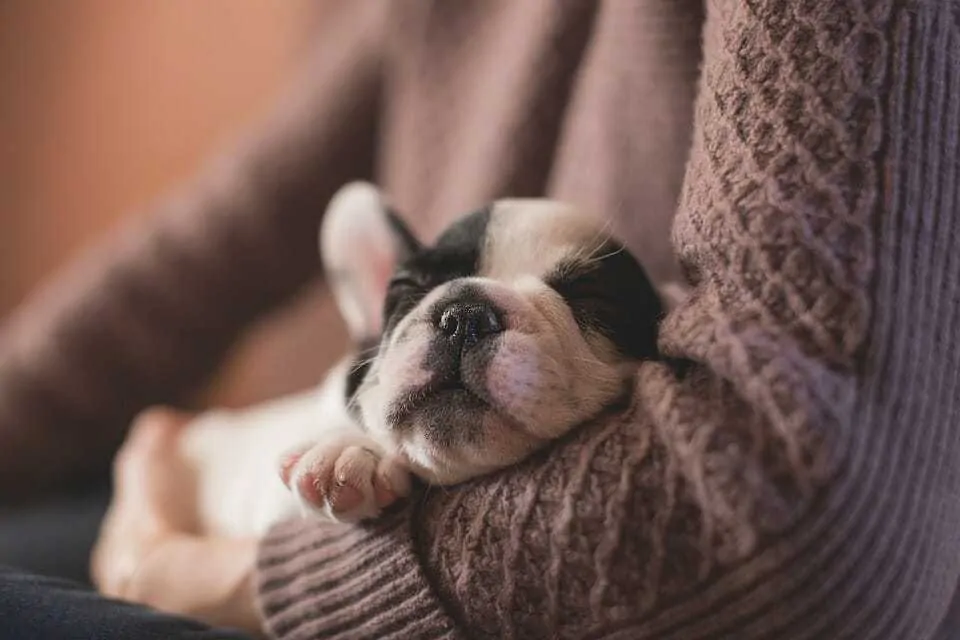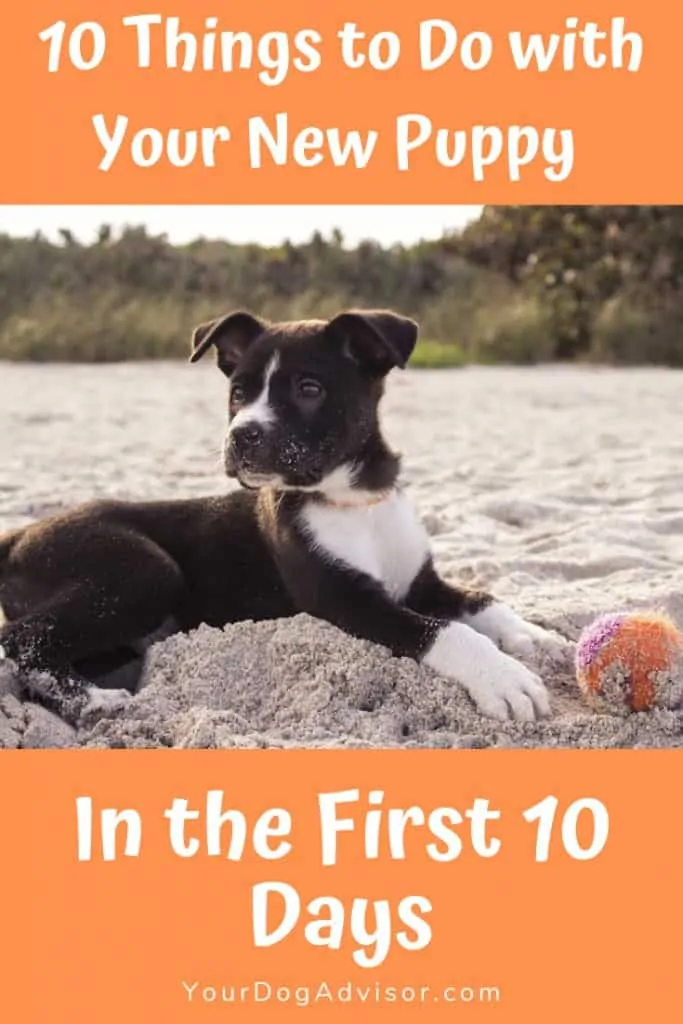Bringing home a new puppy is one of the most exciting moments in the lives of dog lovers everywhere. Here they are, your new loyal companion, your buddy who will be by your side like no human friend ever could.
It’s a beautiful moment. And then you realize what you actually have, is a furry toddler who doesn’t understand English and chews on EVERYTHING.
It’s easy to forget how hard raising a puppy can be. They’re cute and fluffy, and in no time at all, they’ll be that loyal companion you dreamt of. But right now, they are a disaster. And you’re starting to wonder if you’ve bitten off more than you can chew.
>>>Haven’t picked out your new puppy yet? Find out how to use a puppy personality test to find the right pup for you.
If that’s where you are right now, take a breath. Those first ten days with your new puppy may be tough, but they are also some of the most important of your new dog’s life. To make the most of them, and to make your life easier, here are 10 things you should try to do with your new puppy in their first 10 days in their new home.
He may seem like a sweet chocolate lab puppy right now, but in just a few months this guy will be large enough to do some major damage on wood furniture and pull his owner across the street. The right training now will make for an easier future.
Contents
Day 1: Introduce Your Puppy to the Family
No day is more exciting than the day you finally get to bring your puppy home. Whether you’ve been gushing over newborn pics sent to you by the breeder for the last two months or you’ve just fallen in love with a rescue pup at the shelter, today is the day your family grows.
And how your family looks will determine what your puppy’s first day at home should be like.
If you’re single with no other pets, today is all about bonding with your puppy. Remember, if you have a young pup, between eight and 12 weeks old, they probably just left their mother and siblings for the first time. You need to step into that role of caregiver and comfort your pup through this tough transition. Even if you have an older puppy who has been on their own for a month or two, everything about their new surroundings will be different and scary.
If there are more members of the family than just yourself, you must provide comfort while also ensuring your new dog feels safe with everyone else.
If you have young kids, make sure you set boundaries early so they stay consistent as your dog grows. Don’t let your puppy nip or jump up or get too excited around the tiny humans. Quickly redirect them if they get too rough. And make sure to give out loads of praise when they are gentle and calm.
Don’t assume your new puppy will love your other pets. Even young dogs have instincts that might cause friction between them and their new cat, bird, or guinea pig sister. But positive reinforcement and patience can mend that relationship in no time.
With older kids, the discipline may have to be focused in the opposite direction. Make sure your children know how to handle the puppy safely and with respect. They should also feel confident in reading doggy body language and respond appropriately if the puppy doesn’t want to play or gets too rough.
If you have other animal family members in the house, a proper introduction between them and the new puppy is key to finding lasting harmony. Older or territorial dogs may do better meeting the puppy on neutral turf. Go for a walk after to help establish being part of the same pack. Watch your puppy carefully around other furry family members like cats and rodents. Just like with children, set boundaries early and reinforce them consistently.
Day 2: Make Sure Your Puppy is Comfortable in Their Puppy-Space
After all the introductions are over, it’s time to get your new puppy comfortable in their “puppy-space.” This may be a crate, a playpen, or a special room in the house that has been puppy-proofed.
Having a small, puppy-safe place to leave your dog when you go out and overnight is key to successful potty training. It will also help your new dog avoid establishing problem behaviors like chewing and separation anxiety. Just make sure the area is small enough that your dog won’t have accidents. The denning instinct in puppies is limited. If they have enough space to sleep in one corner and relieve themselves in the other, they will.
>>>Baby gates can be helpful for baby dogs too. Check out our picks of the best indoor dog gates.
Whatever your puppy-space is, it should include a comfortable spot to sleep and plenty of chew toys. This should also be the place your dog gets fed and where they receive extra-special treats. Establishing this area of the house as a very positive and safe place to be is your number one goal.
Don’t underestimate the need for good chew treats when you have a puppy. Not only will bully sticks and pig ears keep your dog’s mouth off your furniture, but it also stimulates their mind and helps tire them out.
If at all possible, you should spend at least the first two days home with your new puppy. The longer you can get off of work to stay home, the better. Introduce your dog to the puppy-space before you have to leave them locked up in it for any amount of time. You want your new puppy to feel comfortable in their space before ever leaving them alone there.
As they do become more comfortable, you can start leaving them in their space for short periods while you do things around the house. Give them a peanut butter filled kong, or chew treat before locking them in. This will keep them occupied while you’re away. Ideally, you will return to let them out about the same time they finish the treat. Over time, you can extend your absences so your dog will have to spend some time in their puppy-space without a distraction.
By the time you do have to leave the house for real, your puppy should be comfortable in their space. They should associate being locked in their crate or playpen as a positive thing. And as long as they have gotten plenty of exercise and stimulation before you leave and you return soon enough to give them a potty break, they shouldn’t get too anxious while you’re gone.
Day 3: Create a House-Training Schedule
After you’ve spent a few days getting to know your dog, it’s a good idea to create a house-training schedule. Potty training should be implemented as soon as your new puppy comes home, but you won’t know how frequently they need to be let out or their play/rest schedule until they’ve been with you for a few days.
The worst thing you can do when house training your new puppy is to yell or hit them when they have an accident on the floor. All that will teach them is that going to the bathroom in front of you is dangerous. That will make it harder to get them to potty with you outside and make it more likely they’ll hide when relieving themselves indoors.
It is incredibly helpful to take the time to write down your dog’s potty schedule. This will help keep you consistent. It can also help you spot problems if your dog frequently has accidents around the same time each day.
Start by writing down the time you wake up and take your puppy out each morning. Young puppies need to go out every one to two hours and usually once overnight. While puppies can hold it for about one hour for each month they are old, you should take them out more frequently when you’re home to avoid accidents.
Include in your schedule extra potty breaks for after mealtimes and nap times.
Once you implement the schedule, don’t be afraid to make changes as needed. You should start to get an idea pretty quickly of when your dog usually poops throughout the day. By marking that on your schedule you’ll save yourself time and accidents. If your dog usually only pees after lunch, then you can bring them back in after they pee instead of waiting for more to happen. If they typically poop in the morning, you’ll want to keep a close eye on them and continue taking them out every ten minutes until they’ve done a one and a two.
Day 4: Schedule a Vet Visit
Depending on where your puppy came from and their age, you may need to schedule a vet appointment right away or you may be able to wait a couple of weeks.
Even if you feel confident that you got your puppy from a responsible breeder, a vet check is a good idea. Illnesses can escalate quickly in young dogs and genetic abnormalities may not be obvious without a full physical.
Breeder puppies will usually come from the breeder with up to date shots. Puppy shots are typically given every two to four weeks. Your breeder should give you paperwork indicating when the last shots were given and when the next set is due.
Rescue pups may need shots in addition to what they were given at the shelter or may be on an adjusted schedule depending on their age. It’s a good idea to get these pups to the vet sooner rather than later.
Keep in mind that the first vet visit is about more than just shots. Your vet will check your dog over for any health issues, genetic or acute, and can answer any questions you have about training and socialization. They should also look at your dog’s teeth and check their hearing and vision for any abnormalities. If your dog has a problem in any of these areas, it’s best to learn about it early on.
Day 5: Get Out of the House
Once your dog has been given a clean bill of health, it’s time to get out of the house.
Puppies aren’t fully vaccinated until they’re about four months old, so it’s important to be choosy about where you bring your younger pup. Avoid places that many other dogs go, like the pet supply store or the dog park. Instead, opt for pet-friendly places that see more human traffic than dog.
Getting your dog out of the house will help them get used to new people and places and grow more confident before their window for socialization closes.
Home supply stores usually allow pets and can be a great place to introduce your puppy to new sights and sounds. Friends’ houses and outdoor markets are also good choices for getting out of the house.
The most important thing to keep in mind anytime you expose your dog to new situations is that you need to do everything you can to make the experience positive for them. Puppies go through their first fear period between eight and 10 weeks of age. If something negative happens to a dog during a fear period, it’s likely to be life-changing. If you’re interested in reading an incredible story of how a negative incident during a fear period affected a dog’s life, I recommend this article by Dr. Jen Summerfield.
>>>Already have a fearful pooch? Learn how to help them enjoy a more peaceful life.
To avoid scarring your puppy for life, make sure to watch their body language anytime you are out and about with them. If something makes them nervous, use treats and praise to try and change their opinion of it. If that doesn’t work, remove them from the situation. Be mindful of working up to louder noises and busier places. Try taking your dog to the hardware store on a slow day first. If they seem ok with that, take them back on a busier day. And then, if they’re ready, a weekend.
Use treats, praise, and pets to reinforce to your dog that all these new situations are fun and safe. Ask strangers to greet your puppy and give them a treat to reinforce the idea that people are good, never scary. If your dog sniffs a new object, praise them and encourage their brave curiosity. If your pup spooks at something, reassure them and try reintroducing the object or situation in a more controlled way once they’ve calmed down.
The socialization window for dogs is incredibly short, closing at just 14 weeks old. Dogs born on the streets will remain wary of humans for life because of this. Introducing your puppy to new people and situations will help them become confident and trusting adults.
Most importantly, never force your dog to do something or go somewhere that frightens them. Forcing a dog into a situation that makes them uncomfortable will only add to their anxiety. If your puppy is suddenly wary of something that didn’t bother them a couple of days ago, that’s a good sign they may have entered a fear period. It’s best to keep things calm and quiet during this time and pick up with exploring the world once they’re feeling brave again.
Day 6: Start Playing Impulse Control Games
There are a lot of things a puppy needs to learn. To sit and stay. To walk on a leash. To chew on this and not that. But the most effective way to spend your time with a young puppy is to work on impulse control.
Impulse control, or self-control, plays a vital role in how obedient your dog will be as they get older. You can work for hours a day on the stay command, but if your dog doesn’t know how to keep themselves in check, they’ll never be able to stay while a squirrel runs across the sidewalk in front of them.
Puppies are made to get into trouble. Teaching your dog how to exercise self-control by playing special games will make training things like leave it and wait easier as they get older.
Puppies who are taught self-control from an early age grow up to be dogs who don’t have to be told not to swipe food off the counter and not to run through an open door.
This article outlines seven fun games you can play with your puppy to help develop their impulse control muscle. Young dogs naturally have poor self-control, not unlike toddlers. And this lack of control over their emotions will only get worse as they move into adolescence. Practicing these games with your dog now and continuing to ask more of them as they mature will help avoid a lot of problem behaviors that typically appear in the teenage years.
Think your puppy is too young to start training? Let this little Peanut show you how wrong you are!
Day 7: Set Up a Puppy-Safe Doggy Play Date
While your dog won’t be old enough to go to daycare or most doggy playgroups until they’ve had all their shots, that doesn’t mean they should be quarantined from other dogs. In fact, the socialization window for dogs starts to close around 14 weeks of age, before they’ll receive their final shots. That means now is the most important time to let your puppy make some four-legged friends.
So how do you socialize your puppy without putting them at risk of getting diseases their not vaccinated against?
One simple way is to find a friend with a dog who you know is up to date on their vaccines. A healthy, vaccinated adult dog is very unlikely to be carrying any bugs that could harm your pup. In addition to making sure the dog is healthy, you’ll want to be sure that the dog is well-socialized themselves and will tolerate playing with a young puppy.
Normally, a puppy’s mother would teach them all they need to know about how to behave. Since domestic dogs get taken from their moms at an early age, it’s up to you to find well-socialized adult dogs to teach your pup how to be polite in doggy culture.
Puppies learn everything they need to know about doggy communication by playing and interacting with other dogs. While puppies always love playing with other high-energy pups, they’ll learn a lot more from playing with social-savvy adult dogs.
Adult dogs who communicate with other dogs well will happily put a rowdy puppy in their place. While it may be hard to watch another dog snap at your pup, it is important your dog learn how to play politely and read other dog’s less-obvious signals. These little admonishments will also help teach them impulse control.
Many puppy training classes also offer puppy only play times before or after class. This is a great way to let your pup interact with other dogs and burn off some energy. Usually, these classes are available to puppies 12 weeks and older.
Day 8: Start Leash Training
Walking a young puppy on a leash can be a challenge. They stop constantly, try to pull their collar off, and don’t ever get very far. But it won’t be long before your hesitant pup grows into a confident adolescent who is happy to pull you right off your feet.
Starting leash training now, before your dog learns how to pull, will save you a ton of work in the future.
Your puppy may be hesitant to walk on a leash at first, but it won’t be long until they’re pulling you all over town. Teaching proper leash manners now will save you the headache of changing bad habits later on.
Use tasty treats and praise to teach your dog that good things happen when they walk nicely by your side or without pulling on the leash. If they do surge forward and yank on the leash, simply stop walking. Once they realize they can’t pull you where they want to go, they’ll turn around and release the pressure on the leash. Once they do, praise them and start moving forward. With consistency, your dog will learn that pulling on the leash means they won’t go anywhere.
If your dog has the opposite problem and pulls back on the leash to get away or stops moving altogether, start your leash training inside where they feel safe. Encourage them to move forward with the leash on and reward them for walking nicely. Once they are used to the leash, try walking them in the yard or somewhere familiar. If they balk or panic, don’t pull on the leash. Instead comfort and encourage them with treats and pets.
They’ll grow out of the nervous puppy stage before you know it and then you’ll be glad you started teaching good leash manners before they were strong enough to pull you over.
Day 9: Find Something New to Do
Confident, social adult dogs are created when puppies are exposed to varying situations, different types of people, and lots of other dogs.
Once your dog is comfortable in their new house and their new routine, you should strive to introduce them to one new situation every day.
Dogs who get positive experiences with babies when they themselves are babies are much more likely to tolerate newborns and toddlers as adult dogs.
That may mean taking them to a new place, like the drive up window at the nearest fast-food restaurant or the farmers market up the street. Or it may mean showing them something new, like the train passing by your walking trail or the chickens who live next door.
You also want to work hard to expose your puppy to all types of people. The young, the old, people of different races. People on bikes and skateboards. People in wheelchairs and those who walk with canes. If you don’t have children, find a friend or relative who does and let your puppy play with them.
Most importantly, control every experience so your dog will have a positive impression from it. Taking your puppy to the Fourth of July parade may seem like a good idea until the fire engine sirens and horns go off and a kid swings a sparkler in their face. If you want a dog who will suffer from noise phobia all their life, that’s a great idea. If you want a confident adult dog who can go anywhere, try setting out a blanket a few blocks from the parade. Let your dog hear the sounds and watch the crowd from a distance while you feed them treats and comfort them.
Day 10: Strengthen Your Bond
As important as socialization, impulse control training, and exposure are to your dog’s development, nothing trumps their bond with you.
Using positive training techniques will ensure your dog grows into a confident adult who trusts and looks to you for guidance. Taking time to establish a bond with your new puppy before leaving them alone will help avoid anxiety and destructive tendencies later on. And experiencing new things with you by their side will cement your bond as their packmate and leader.
Puppies are easy to love and cuddle at this age. Take advantage of it while you can. When they become high-energy teenagers, this bonding time will be the difference between a relationship that thrives and one that barely survives.
Of course, none of this stops on day 10. Your new puppy will continue to be a part of your life long after their oversized feet and puppy breath have gone away. Continue working to strengthen your bond with your new dog every day you’re together. As they enter adolescence, they will do everything they can to test your relationship. Be prepared for this difficult phase by emphasizing training and self-control work now.
Pretty soon you’ll look down at your puppy and realize they’re not a puppy anymore. Suddenly they’re a confident, happy adult. And the loyal best friend you were hoping for.

Sara Seitz has spent most of her life in the pet industry and has a bachelors in animal behavior from Colorado State University. Sara started working with dogs and cats as a high schooler at a rural boarding kennel. There she learned a lot about the bad and the ugly of the pet service industry. But not even the toughest day at that job would dissuade Sara from following her dream of working with animals.
In college, Sara got a job at a dog daycare and boarding facility in Fort Collins, Colorado. Her new career provided even more opportunities for learning about dog behavior than her classes did. As general manager of the daycare, Sara helped the company launch a new in-home pet sitting branch and trained to become a certified dog trainer. Between shifts taking care of peoples pets in-home and supervising dogs during playtime at the daycare, Sara organized and taught obedience classes.
Sara has always been passionate about bettering the lives of our canine companions. She soon found that advocating for and educating owners in the power of positive reinforcement training was one of the best ways to help dogs and their owners live happier lives.
